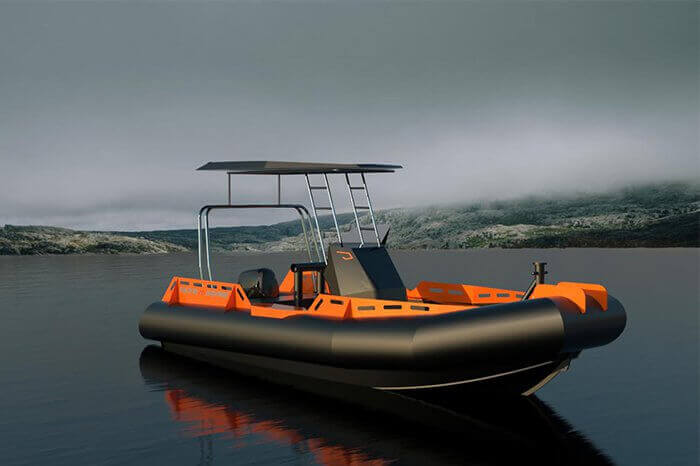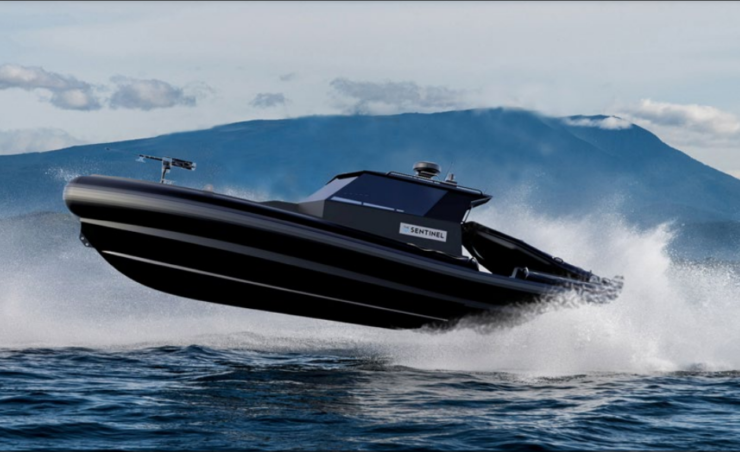
PFG, a Tasmanian company on May 10 unveiled its Sentinel 1100 -11m-long tactical watercraft designed primarily for maritime interdiction. The watercraft was unveiled at the international maritime exhibition, Indo-Pacific 2022 held in Sydney. The highlight of the boat is that it is made with High-Density Polyethylene (HDPE), a unique material which is highly durable, malleable and light in weight, as compared to materials that are traditionally used to build boats. Above all, HDPE steeply reduces the manufacturing cost of boats.
This new craft features HDPE on its hull and deck, and offers superior durability and reliability in the context of sustained force and is also optimised for repeated air drops and hard beaching. HDPE’s vibration absorption properties dampen noise, minimise slamming and personnel fatigue while its high stability and responsive handling reduces rollover risk.
Sentinels are manufactured to ISO NSCV or Class Society Standards and HDPE has an industrial strength, positive buoyancy and is non corrosive with ballistic protection. The material has been sourced from Germany and can outperform even composite materials in terms of impact and absorption of vibration
The manufacturer’s claim that Sentinel has a life span of 100 years as the HDPE will last four times longer than alternative materials and comparative weights.
The Sentinel 1100 has the capacity to carry three crew and ten passengers. Powered by two Cummins QSB6.7 engines and brand new HJX29 water jets from Hamilton, it can achieve a speed of more than 45kt and is equipped with manoeuvrability similar to spinning on an axis, moving sideways and dynamic positioning.
The boats are built with 900 litre fuel tank capacity, which is scalable. The boats come with an open deck or a cabin. Consoles can be mounted forward in the centre, side or rear, giving users plenty of options. Guns can be mounted on these boats.

What is HDPE?
HDPE is a thermoplastic polymer made from petroleum. Considered as the most versatile of plastic materials, HDPE is used in manufacturing plastic bottles, milk jugs, shampoo bottles, bleach bottles, cutting boards and piping, snowboards, food and beverage containers..
Known for its outstanding tensile strength and large strength to density ratio, HDPE has a high impact resistance and melting point. The material is also highly malleable. Once it reaches melting point, the it can be quickly and efficiently moulded for use across applications like food storage containers, corrosion resistant piping, geomembranes, plastic tumblers and so on. However, HDPE cannot sustain very high temperatures. The density of HDPE can range from 0.93 to 0.97 g, although the density of HDPE is only marginally higher than LDPE (low-density polyethylene).
It is also used in wood plastic composites and in plastic surgeries, specifically skeletal and facial reconstruction.
HDPE does not rot, and it resists mildew and fungus formation and is weatherproof. Being a long lasting material, the material is ideal for manufacturing underground pipes such as seweage and water supply pipes.

Why Use HDPE?
HDPE can replace heavier materials and thus helps organisations attain sustainability goals. Besides, using the material reduces manufacturing cost of products thus making them affordable for customers. HDPE is a perfect combination of strength and cost efficiency and is also eco-friendly.
– The writer is an Aerospace and Defence Analyst & Director ADD Engineering Components (India) Pvt Ltd (An Indo- German Company).








